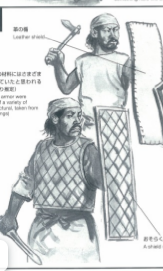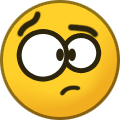-
Posts
25.684 -
Joined
-
Days Won
300
Everything posted by Lion.Kanzen
-
Hime (Old Japanese Pi1me1), (姫, "young noblewoman; princess"), explains Miller, etymologically derives from hi (Fi1) (日, "sun") and me (me1) (女, "woman"). Tsunoda[35] notes that "Pimiko is from an archaic Japanese title, himeko, meaning 'princess'"; that is, hime with the female name suffix -ko (子, "child"), viz. the uncommon given name Himeko. Other Amaterasu-related etymological proposals for the Japanese name Himiko involve hi (日, "sun") and miko (覡 or 巫女, "female shaman, shamaness; shrine maiden; priestess"); or their combination hime-miko, "princess-priestess".[citation needed] Bentley[36] considers the Baekje word *pye, 'west', the honorific prefix *me and *hɔ, 'heir', and thus interprets 卑彌呼 as 'the honorific heir of the west'.
-
https://www.skyscrapercity.com/threads/where-did-japanese-come-from-the-roots-of-the-japanese.890420/page-14 https://www.iz2.or.jp/english/@#$%usyoku/@#$%usei/4.htm
-
Two other Chinese dynastic histories mentioned Himiko. While both clearly incorporated the Wei Zhi reports, they made some changes, such as specifying the "some seventy or eighty years" of Wa wars occurred between 146 and 189, during the reigns of Han Emperors Huan and Ling. The c. 432 Book of Later Han (Hou Han Shu 後漢書) says "the King of Great Wa resides in the country of Yamadai", rather than the Queen: In terms of Japanese phonology (which historically did not have the consonant /h/ and whose modern /h/ evolves from historical /p/),[34] the accepted modern reading of 'Himiko' would regularly correspond to Old Japanese *Pimeko. However, Roy Andrew Miller says *Pimeko is a lexicographic error deriving from the Wei Zhi transcriptions
-
Done. I contact Stan on Telegram.
-
you better be careful because I can talk to an admin.
-
I'm not sure, but they consider me least or last.
-
.thumb.png.ce58cea22940c255f5b0a735d5abee36.png)
Idea: Attack structures in a more "realistic" way.
Lion.Kanzen replied to Lopess's topic in Gameplay Discussion
That is already technical, that depends on how they define it. -
Japnese sources: Neither of the two oldest Japanese histories – the c. 712 Kojiki[15] nor c. 720 Nihon Shoki[16] – mentions Queen Himiko. The circumstances under which these books were written is a matter of unending debate, and even if Himiko were known to the authors, they may have purposefully decided not to include her.[17][18] However, they include three imperial-family shamans identified with her: Yamatototohimomosohime-no-Mikoto (ja), the aunt of Emperor Sujin (legendary 10th Japanese emperor, reigned 97–30 BC) and daughter of Emperor Kōrei; Yamatohime-no-mikoto, the daughter of Emperor Suinin (legendary 11th, reigned 29 BC–70 AD); and Empress Jingū (reigned c. 209–269 AD), the wife of Emperor Chūai (legendary 14th emperor, reigned 192–200 AD). These dates, however, are not historically verified. One remarkable exception to early Japanese histories overlooking Himiko is the Nihon Shoki, quoting the Wei Zhi three times. In 239, "the queen [女王] of Wa" sent envoys to Wei; in 240, they returned "charged with an Imperial rescript and a seal and ribbon;" and in 243, "the ruler [王 "king"] of Wa again sent high officers as envoys with tribute".[19] It is revealing that the Nihon Shoki editors chose to omit the Wei Zhi particulars about Himiko. Yamato Totohi Momoso himemiko (倭迹迹日百襲媛命), the shaman aunt of Emperor Sujin, supposedly committed suicide after learning her husband was a trickster snake-god. The Kojiki does not mention her, but the Nihon Shoki describes her as "the Emperor's aunt by the father's side, a shrewd and intelligent person, who could foresee the future".[20] After a series of national calamities, the Emperor "assembled the 80 myriads of Deities" and inquired by divination. Yamato-totohi-momoso was inspired by Ōmononushi-nushi ("Great Deity of All Deities and Spirits"),[21] to say: "Why is the Emperor grieved at the disordered state of the country? If he duly did us reverent worship it would assuredly become pacified of itself." The Emperor inquired, saying: "What God is it that thus instructs me?" The answer was: "I am the God who dwells within the borders of the land of Yamato, and my name is Oho-mono-nushi no Kami."[22] While imperial worship of this god (from Mount Miwa) was "without effect", Yamato-totohi-momoso later married him.
-
The "Records of Wei" also records envoys travelling between the Wa and Wei courts. Himiko's emissaries first visited the court of Wei emperor Cao Rui in 238, and he replied: Finally, the "Records of Wei"[10] records that in 247 when a new governor arrived at Daifang Commandery in Korea, Queen Himiko officially complained of hostilities with Himikuko (卑弥弓呼, or Pimikuko), the king of Kuna (ja) (狗奴, literally "dog slave"), one of the other Wa states. The governor dispatched "Chang Chêng, acting Secretary of the Border Guard" with a "proclamation advising reconciliation", and subsequently:
-
Himiko (卑弥呼, c. 170–248 AD), also known as Shingi Waō (親魏倭王, "Ruler of Wa, Friend of Wei"),[1][a] was a shamaness-queen of Yamatai-koku in Wakoku (倭国). Early Chinese dynastic histories chronicle tributary relations between Queen Himiko and the Cao Wei Kingdom (220–265) and record that the Yayoi period people chose her as ruler following decades of warfare among the kings of Wa. Early Japanese histories do not mention Himiko, but historians associate her with legendary figures such as Empress Consort Jingū, who was regent (c. 200–269) in roughly the same era as Himiko.[citation needed] Scholarly debates over the identity of Himiko and the location of her domain, Yamatai, have raged since the late Edo period, with opinions divided between northern Kyūshū or traditional Yamato Province in present-day Kinki. The "Yamatai controversy", writes Keiji Imamura, is "the greatest debate over the ancient history of Japan."[4] A prevailing view among scholars is that she may be buried at Hashihaka Kofun in Nara Prefecture. The first historical records of Himiko are found in the Records of the Three Kingdoms This early history describes how Himiko came to the throne: I imagined it, it didn't look like a sword to me.
-
bronze bleade. http://www.gondo.com/gyarari/photo/hakuran/digj2008E.htm
-
interesting...
-
An example of how bronze whorl plaques may have been used, based on items found mounted on shields of the Kofun period https://archaeology.jp/sites/2008/sakura.htm
-
-
already exists in the game, she should be able to train male bodyguards.
-
-
.thumb.png.ce58cea22940c255f5b0a735d5abee36.png)
Idea: Attack structures in a more "realistic" way.
Lion.Kanzen replied to Lopess's topic in Gameplay Discussion
If you remove it, the archers/spearmen will damage it with missiles/ or melee attacks as if it were a like a paper building. -
I want beyond the military I need help from you from someone competent in gameplay and patch implementation.
-
yes, a knife user. defense weak. faster strikes. cheap.
-
in AoE Iv i was watching a spanish video and anti cavalry melee type units can stun a cavalry unit. what it means is that cavalry even if they have more mobility, they can be trapped by a spear. the video says it's a skill to increase the riskiness of the hit and run.
- 158 replies
-
- 2
-

-
- @stan
- @hannibal_barca @andybeauty
- (and 9 more)
-
I therefore propose to take advantage of this and make a bigger project to expand the technologies of the game. not in this post in the long term.
-
@wowgetoffyourcellphone ideas. what kind of sacrifices?
-







